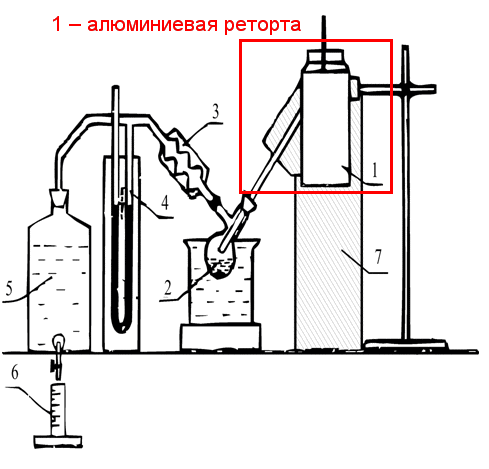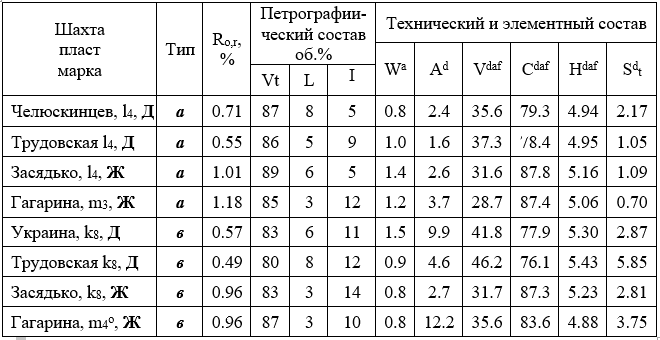Intensification of the process of thermal degradation of coals in the temperature range of semicoking
Content
- Introduction
- 1. The relevance of the topic
- 2. The goals and objectives of the study
- 3. Research methods
- 4. Experimental part
- Conclusions
- List of sources
Introduction
Donbass is rich in reserves of solid fuels. This is the most important source of energy and chemical products not only for our region. Thermal processing of solid fuels is used to obtain a refined carbonaceous solid materials and liquid and gaseous products [1].
Methods of use the coal mined is different. It is used in industry and in everyday life. In industry, it often happens that coal is the raw material for the production of semi-coke and coke. Not all coals are suitable for obtaining high-quality coke. Immature low-quality coals suitable for semi-coking.
Semi-coking is one of the methods of complex processing low-grade solid fuels with the receiving char, and a range of products, which are raw materials for the chemical industry. Semi-coke is used as easy lighting of smokeless solid fuel in industry and everyday life [2].
1. The relevance of the topic
Coal is the most common in the world of non-renewable energy resource. It became the first fossil fuel used by humanity. The use of coal in the modern world has many ways. It is used to produce electrical energy, to chemical industry, as a raw material for metallurgical etc.
Donetsk coal basin – one of the most important coal basins in the former Soviet Union. Located mainly in the Donetsk, Dnipropetrovsk and Rostov regions [4]. It suggests that the development and improvement of the coal industry is always important for our region.
The bulk of the coals, brands such as G, F, C, and ÑS, are coking. However, about 70 % of the Donbass coal – sour, so it is unfit for coking. Semi-coking is a promising method of processing unfit for coking coals (Semi-coking is the process of heating a specially prepared coal charge without access of air up to 500-550 °C. This process takes place at a temperature approximately twice lower than the coking temperature). Currently semi-coking solid fuel is considered not only as a supplier of hydrocarbons, but also as one of the main stages of different production processes (plants for the production of synthetic liquid fuels, power technology and chemical processing plant solid fuel) [3].
Thus, intensification and improvement of processes taking place in the temperature interval of semi-coking, more valuable products from low grade coals, is a topical issue of modern coal chemical industry.
2. The goals and objectives of the study
The aim of this work is intensification of the process of semi-coking in the presence of various chemical additives; evaluation of the effect of additives on the yield, composition and properties of pyrolysis products.
The object of research is low-metamorphosed coals of the Donets basin, pre-treated with chemical additives with a high exit of volatile substances.
This study is focused on thermal conversion of coal in a temperature range of semi-coking, and also studying of influence of chemical treatment on the yield and composition of semi-coking products. The first stage of this work was to identify the structural parameters, determining the behavior of coals during heat treatment.
3. Research methods
To accomplish the task, used a combination of thermal and physical-chemical methods of research. semi-coking carried out by the classical method in the retort Fisher – Method of determination of output of products of semi-coking
(GOST 3168-93, ISO 647-74). Elemental and technical analysis of samples made according to GOST 12113-94, ÃÎÑÒ 27314-91, ÃÎÑÒ 11022-95.

Figure 1 – Laboratory equipment for semi-coking
BrukerFTS-7 with the use of equipment DRIFT in the Institute of organic chemistry with centre of Phytochemistry, Bulgarian Academy of Sciences. Coal for analysis were prepared in the form of a 5 % aqueous mixtures with potassium bromide. The IR spectra of samples removed in the region of wave numbers γ = 4000 – 400 cì-1. Correction of baseline was done using the computer program
ODP. Correlations were identified using the program
Excel 2016.
4. Experimental part
As objects of study used pairs of restored and slabosolenym of Donetsk basin coals of different metamorphic stages. Characteristics of the initial coals is given in Table.1.

Table 1 – Characteristics of the studied coals
As can be seen from the table, coal reduced type â compared to their somatomedinami couples of type à are characterized by high content of hydrogen sulfur and a large yield of volatile substances. All the selected coals contain more than 80 % of the microcomponents of the vitrinite group.
The study of changes of the elemental and group composition of the studied coals has revealed new, previously unknown correlation, which is shown in Ðèñ.1-4.




As can be seen from Ðèñ.1, the degree of conversion of organic mass of coal into liquid and gaseous products vary equally with changes in the solubility in dichloromethane. The calculated value of the correlation coefficient between the yield of soluble products and the degree of conversion in gas-vapor products in the temperature interval of semi-coking is 0, 986.
This fact, in our opinion, is consistent with the data Gryaznov [5] that the reduction of oxygen when heated above 3000 °Ñ leads to an increase of solubility in organic solvents. However, in the present experiment is not detected the above-mentioned relationship between the yield of soluble products and the loss of oxygen (R2≤0,5).
It should be noted that coal is described in the literature correlations, as a rule, concern the relationship between properties of coal and their elemental composition.
In this paper, we study the relationship between group composition of coals, a certain method of IR-spectroscopy, and their technological characteristics. As can be seen from Fig.2 and 3, there is a excellent correlation between the solubility of coal, output vapor-gas products of semi-coking, on the one hand, and modifying the content aromatische hydrogen, on the other hand.
Based on the concept that in the process of low-temperature pyrolysis and dissolution is the destruction of intermolecular interactions in the structure of high-molecular compounds comprising the organic mass of coal, it seemed interesting to analyze the change in this parameter when semi-coke. The strength of intermolecular interactions was estimated by the ratio of the intensities of the absorption bands I1700⁄I2920. As can be seen from Ðèñ.4, there is a strong correlation between the strength of intermolecular interactions and access paragenetically water.
The second stage is the intensification of the process of decomposition of organic mass of coal in the temperature range of semi-coking by introducing additives that promote the destruction of intermolecular interactions.
As an additive we used a 25 % solution of Tetramethylammonium in methanol. It is quaternary ammonium compound. It is used as the anisotropic Etchant for silicon. Also used as the main solvent. Is a phase transfer catalyst. Also used as a surfactant during the synthesis of ferromagnetic fluids to prevent caking of its particles.
A solution of Tetramethylammonium is a strong base. Its ions can damage nerves and muscles, leading to difficulty breathing and possibly death soon after contact with even small amounts. Net Tetramethylammonium virtually odorless, contaminated with trimethylamine (which is used in the production of quaternary ammonium salts) has the smell of dead fish [6].
Conclusions
In the present work were evaluated the changes of the elemental and functional composition of the organic mass of coal in the process of semi-coking and the relationship between these changes and yield of pyrolysis products as well as products soluble in organic solvents. The presence of correlations between the structural-group composition of solid fuels and their solubility in organic solvents and behavior during heat processing.
Thus, the results of the study show the effect of intermolecular interactions and the processes of redistribution of hydrogen on the results of low-temperature pyrolysis and solubility of coals.
List of sources
- Pyrolysis of coal [Electronic resource]. – Mode of access: https://www.potram.ru/...
- Semi-coke [Electronic resource]. – Mode of access: https://ru.wikipedia.org/wiki/...
- The research products of semi-coking coal mix with a high sulfur content [Electronic resource]. – Mode of access: http://ea.donntu.ru:8080/...
- Donetsk coal basin: from past to future [Electronic resource]. – Mode of access: http://greenologia.ru/eko-problemy/...
- Gryaznov N. With. Plastic state and sintering coal / N. With. Gryaznov. – Sverdlovsk, 1962. – 191 p.
- Hydroxide of Tetramethylammonium [Electronic resource]. – Mode of access: https://ru.wikipedia.org/wiki/....
